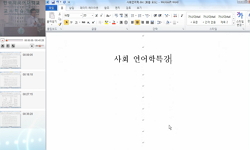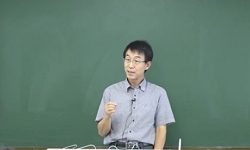Kim Euk always had an interest in the dilemma of language and literature in modern space of Chosun. While translating and introducing foreign poems from late 1910s, he was concerned about the language and form of the poem. Also, he learned Esperanto l...
http://chineseinput.net/에서 pinyin(병음)방식으로 중국어를 변환할 수 있습니다.
변환된 중국어를 복사하여 사용하시면 됩니다.
- 中文 을 입력하시려면 zhongwen을 입력하시고 space를누르시면됩니다.
- 北京 을 입력하시려면 beijing을 입력하시고 space를 누르시면 됩니다.
부가정보
다국어 초록 (Multilingual Abstract)
Kim Euk extended Esperanto language continuously to the public as well, according to such awareness. He used Esperanto literature as a tool to learn the cosmopolitan sense.
Kim Euk realized that Esperanto language was the language with the commonality of the world, and that it transformed the fullest affection of literature of the people from all around the world. Also, he thought that this language was qualified for the poetic diction as it contained ‘life’ and ‘spirit,’ and had the characteristic of ‘one letter one sound,’ which was ideal for the language. Since Esperanto letters could clearly depict ‘sound,’ he believed that the poem could illustrate ‘musicality’ so that it could arouuse ‘sense’ and ‘motion’ of the people of the world.
Kim Ok, hoped for the globalization of Chosun as Koreans (of Chosun Dynasty) learned the cosmopolitan sense through Esperanto language and literature.
Kim Euk always had an interest in the dilemma of language and literature in modern space of Chosun. While translating and introducing foreign poems from late 1910s, he was concerned about the language and form of the poem. Also, he learned Esperanto language, an artificial language created by Zamenhof, during his days of studying in Japan in mid-1910s, and wrote poems. Media at that time claimed that Koreans (of Chosun Dynasty) should become more universal citizen of the world, and that they should learn Esperanto language as the driving force.
Kim Euk extended Esperanto language continuously to the public as well, according to such awareness. He used Esperanto literature as a tool to learn the cosmopolitan sense.
Kim Euk realized that Esperanto language was the language with the commonality of the world, and that it transformed the fullest affection of literature of the people from all around the world. Also, he thought that this language was qualified for the poetic diction as it contained ‘life’ and ‘spirit,’ and had the characteristic of ‘one letter one sound,’ which was ideal for the language. Since Esperanto letters could clearly depict ‘sound,’ he believed that the poem could illustrate ‘musicality’ so that it could arouuse ‘sense’ and ‘motion’ of the people of the world.
Kim Ok, hoped for the globalization of Chosun as Koreans (of Chosun Dynasty) learned the cosmopolitan sense through Esperanto language and literature.
목차 (Table of Contents)
- 1. 문제제기
- 2. 1920-30년대 에스페란토 운동 전개
- 3. 김억의 에스페란토 인식 - 문학어
- 4. 맺음말
- 참고문헌
- 1. 문제제기
- 2. 1920-30년대 에스페란토 운동 전개
- 3. 김억의 에스페란토 인식 - 문학어
- 4. 맺음말
- 참고문헌
- [Abstract]
참고문헌 (Reference)
1 임형택, "흔들리는 언어들" 성균관대학교 출판부 2008
2 정우택, "황석우연구" 박이정 2008
3 김준오, "현대시의 방법론과 모더니티" 새미 2009
4 김삼수, "한국에스페란토운동사" 숙명여자대학교출판부 1976
5 구승회, "한국 아나키즘 100년" 이학사 2004
6 정우택, "한국 근대 초기시에서 '외래성'과 '근대성'의 문제" 한국시학회 (19) : 31-61, 2007
7 "학생계"
8 "태서문예신보"
9 앤서니 아노브, "촘스키 知의 향연" 시대의 창 2013
10 "조선일보"
1 임형택, "흔들리는 언어들" 성균관대학교 출판부 2008
2 정우택, "황석우연구" 박이정 2008
3 김준오, "현대시의 방법론과 모더니티" 새미 2009
4 김삼수, "한국에스페란토운동사" 숙명여자대학교출판부 1976
5 구승회, "한국 아나키즘 100년" 이학사 2004
6 정우택, "한국 근대 초기시에서 '외래성'과 '근대성'의 문제" 한국시학회 (19) : 31-61, 2007
7 "학생계"
8 "태서문예신보"
9 앤서니 아노브, "촘스키 知의 향연" 시대의 창 2013
10 "조선일보"
11 "조선문단"
12 구인모, "절대적 보편과 형상에 대한 신념 -김억의 언어 인식과 시학-" 한국문학연구학회 (45) : 243-273, 2011
13 "이광수전접 1"
14 김윤식, "에스페란토文學을 通해 본 金億의 譯詩攷" 한국교육학회 14 : 26-69, 1968
15 안종수, "에스페란토, 아나키즘 그리고 평화" 선인 2006
16 허발, "언어와 정신" 열린책들 2013
17 허재영, "안서 김억의 언어관과 한글 문법론" 인문과학연구소 (35) : 207-226, 2012
18 김우선, "선구자 김억" 한국에스페란토협회 2000
19 신지연, "민족어와 국제공통어 사이 - 김억을 바라보는 한 관점 -" 민족문화연구원 (51) : 377-417, 2009
20 레오 바이스게르버, "모국어와 정신형성" 문예출판사 2004
21 "동아일보"
22 박슬기, "김억의 번역론, 조선적 운율의 정초 가능성" 한국현대문학회 (30) : 103-132, 2010
23 沈善玉, "근대시 형성과 번역의 상관성―金億을 중심으로" 대동문화연구원 (62) : 321-351, 2008
24 "근대사조"
25 "개벽"
26 C. D. 루이스, "詩란 무엇인가" 탐구당 1984
27 조영복, "1920년대 초기 시의 이념과 미학" 소명출판 2004
28 김경미, "1920년대 에스페란토 보급 운동과 민족운동 세력의 인식" 역사학연구소 16 : 133-163, 2006
동일학술지(권/호) 다른 논문
-
- 한국어문학회
- 정은영(Jeong, Eun-young)
- 2013
- KCI등재
-
- 한국어문학회
- 최은숙(Choi, Eun-sook)
- 2013
- KCI등재
-
- 한국어문학회
- 박진(Park, Jin)
- 2013
- KCI등재
-
- 한국어문학회
- 양정임(Yang, Jung-im)
- 2013
- KCI등재
분석정보
인용정보 인용지수 설명보기
학술지 이력
| 연월일 | 이력구분 | 이력상세 | 등재구분 |
|---|---|---|---|
| 2026 | 평가예정 | 재인증평가 신청대상 (재인증) | |
| 2020-01-01 | 평가 | 등재학술지 유지 (재인증) |  |
| 2017-01-01 | 평가 | 등재학술지 유지 (계속평가) |  |
| 2013-01-01 | 평가 | 등재학술지 유지 (등재유지) |  |
| 2010-01-01 | 평가 | 등재학술지 유지 (등재유지) |  |
| 2008-01-01 | 평가 | 등재학술지 유지 (등재유지) |  |
| 2006-01-01 | 평가 | 등재학술지 유지 (등재유지) |  |
| 2004-01-01 | 평가 | 등재학술지 유지 (등재유지) |  |
| 2001-07-01 | 평가 | 등재학술지 선정 (등재후보2차) |  |
| 1999-01-01 | 평가 | 등재후보학술지 선정 (신규평가) |  |
학술지 인용정보
| 기준연도 | WOS-KCI 통합IF(2년) | KCIF(2년) | KCIF(3년) |
|---|---|---|---|
| 2016 | 0.56 | 0.56 | 0.56 |
| KCIF(4년) | KCIF(5년) | 중심성지수(3년) | 즉시성지수 |
| 0.54 | 0.53 | 0.99 | 0.1 |




 DBpia
DBpia







